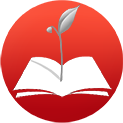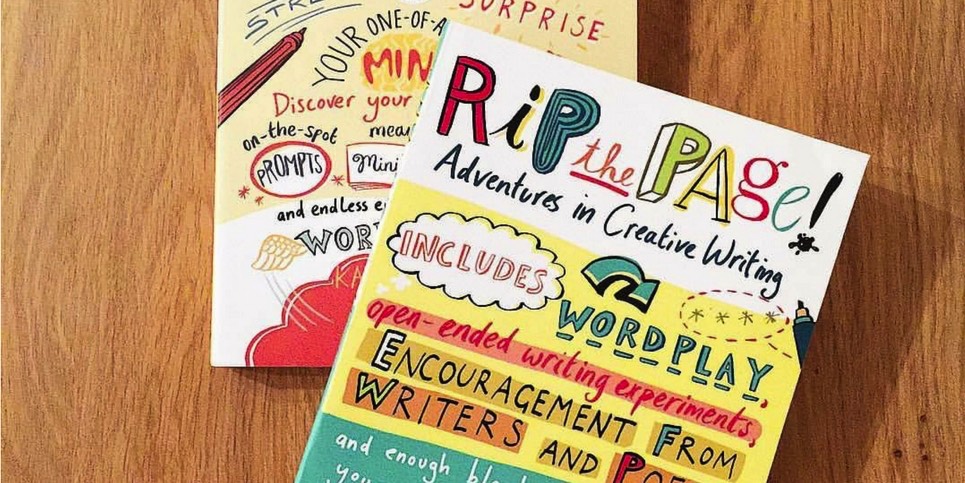Nicki Richesin | The Children’s Book Review | April 9, 2014
It’s National Poetry Month this April and what better way to celebrate than a chat with author, poet, and creative writing instructor Karen Benke.
Karen is the author of two wonderfully magical books about creative writing Rip The Page! and Leap Write in! Both of these empowering books will inspire your child/tween/teen (or even inner child) to write with more joy and wild abandon and may even unleash a hidden writer. Let’s “leap write in” with Karen…
Nicki Richesin: After reading your books, you seem like you should be an ambassador or Nobel Laureate for creative writing. How did you first come up with the idea for Rip the Page?
NR: Both your books offer a treasure trove full of writing prompts, wise advice from authors, inspiration, and life lessons along the way, such as how to cultivate gratitude. How did you assemble this vast collection of writing exercises and magical prompts?
KB: As a poet-teacher who spent a lot of time with elementary school-aged kids, I thought a lot about how I felt as a second, third, and fourth grader and how I loved to write and longed to hear and learn things with catchy phrases, images, and visuals. I thought about what kind of teacher I learned best from and what kind of book I wish I’d had as a shy third grader with so many feelings and images swirling through me. My son and I would read a lot together when he was younger, and I kept notes on our favorite passages and favorite authors…so when I got around to assembling my collection, I started contacting these authors. All I was asking for was a small note to a child, offering some writing encouragement. It’s hard to say no to that. Then with the help of my amazing editor at Roost Books/Shambhala, Jennifer Urban-Brown, and a lot of re-writing and paring down, we built the book around these notes of encouragement. It was a messy business taming all those magical prompts, but Jenn was able to connect my short chapters into a sort of call and response that could play and dance throughout the book. I kept those 8-11 year-olds in my heart while I assembled and was teaching a lot at the time so could see first hand what worked with them and what didn’t. It was all a messy, joyous experiment in patience!
NR: What has surprised you the most during your journey teaching kids creative writing? What have you discovered about writing poetry from them?
KB: What has surprised me the most is how hungry kids are to play on the page, to be given permission to please themselves…and that it’s really okay if the sense they make is in the form of a 2+2=5 equation. I’ve learned that a simple invitation and a knock out example poem is often all that’s needed by way of a nudge to get them started. (And if I’m genuinely excited about the writing experiment we’re doing…) There’s so much more that kids want and need to express beyond that narrow margin of greatness they often get measured by in school. They’ve taught me how to reassure them that there’s no right way or wrong way, but simply their way to write a poem or creative blast. They’ve led me down the winding path of discovery to see first hand how poems are sometimes bold and can just as often—more often—be shy. A just-born poem needs our care and attention. Poems, like children, don’t respond well to criticism and harshness, but do blossom when given space to be strange and surprising and real. One of my colleagues in the CPITS program, Prartho Sereno, a wonderfully imaginative poet and teacher, calls the second graders, “The Mystics,” a definition I whole-heartedly agree with. I call the third and fourth graders “The Kindness Bearers.” That about sums it up: my journey all along has been to learn and accept the depth of kindness in my own heart and to really feel it so as to share it and receive it back from the children. It’s a feedback loop filled with endless possibility.
NR: When did you first fall in love with poetry?
KB: I fell in love with poetry second semester of my freshman year of college. I signed up for an afternoon elective course with the poet Gary Thompson, because my psychology and statistics classes were dragging me down. (I started out as a psychology major and soon switched to English.) By my sophomore year, I found myself wanting to read and write poetry all the time. I thought in pictures and images anyway and had always been attuned to the tone of people’s voices. Gary was sensitive about the poets he introduced me to…and the way he critiqued my early drafts and shy first attempts at poem-making. He knew how far to push me and when to back off. He was incredibly kind, used to invite me to walk with him to the local post office to check his mailbox. He was a fine example of a working poet. My fate was sealed.
NR: What’s the best writing advice you’ve ever received?
KB: Allow for strangeness…. and be willing to be surprised, both by yourself and by the poem. My teacher in graduate school and now friend, Jane Hirshfield, offered this…
NR: Do you have a cherished poem that you keep in mind as a touchstone for your life?
KB: I tend to have cherished collections of poems and specific poets I fall for. Among them: Linda Gregg, Jack Gilbert, Catherine Barnett, Jane Hirshfield, Joseph Stroud… Recently a poem that keeps finding me and asking to be memorized is Elizabeth Bishop’s “One Art.” I’ve been losing things—small things and big things— living in a perpetual state of loss, or so it has felt, for a while. Maybe that’s why this poem continues to seek me out. Bishop suggests we practice getting used to losing little things everyday—keys, the hour badly spent— so that when the big losses come along—houses, cities, people—we’ll have had some practice. The poem’s about a lot more than this and is an amazing poem to read out loud. It teaches me something new with each reading.
NR: Do you believe in Writer’s Block? And if so, what’s the cure?
KB: I don’t believe in Writer’s Block anymore. I do believe that we all have these monkey minds that like to convince us—trick us—into believing there’s this thing called Writer’s Block out there and we can get it, catch it, almost like a cold…and then not be able to write. I believe there are times when we need to switch our focus and take a break from writing to simply move and walk and stretch or simply stare out a window, pet the cat, bake a tin of brownies. Sometimes feeling an old grief has kept me from my writing, or so this is the excuse I’ve made. Sometimes I have to remind myself to be gentle and kind and treat myself like I do my students…to encourage myself to just sit down in the middle of it all—the real and perceived mess—and doodle a bit. Entering the writing sideways or at a slant takes the pressure off.
NR: Where do you seek inspiration?
KB: I seek inspiration from things near and far. My son once said upon waking from a nap, “I want to go on a Sa-near-i today not a Sa-far-i.” So sometimes I take Sa-near-ies. Sometimes I just sit with certain nearby objects—a lit candle, a vase of flowers, a corner of a room I haven’t visited in a while. Sometimes in the middle of the day I take a twenty minute nap. I wake refreshed and ready to see the world anew. Sometimes traveling someplace I haven’t been to for a long while—or ever—helps me to turn around and see my other life with some distance and appreciation. Definitely being with my son and husband and cat Clive is inspiring. And I, of course, seek out certain writers for inspiration—Keri Smith, Cheryl Strayed, Austin Kleon, Ann Patchett as of late. After a yoga practice with a favorite teacher, inspiration for writing ideas abound. Especially after a backbend or handstand or my particular favorite: corpse pose
NR: How do you like to celebrate National Poetry Month?
KB: For the past four years, I’ve celebrated by leading a “play shop” at the Mill Valley Library for 8-11 year-olds who like to rip pages from old books and make magic word tickets. We make a mess of the Creekside Room, call out favorite word combos, eat snacks, create small poems and then ride the elevator upstairs to decorate the tall wooden wall that leads into the Children’s Room. Our poems stay up for the entire month and get visited often.
KB: Ready.
NR: What is your favorite…
Verb: slither
Noun: mountain
Simile: Read like a wolf eats (from Sandra Cisneros)
Metaphor: Poetry is a sofa full of blind singers who have put aside their canes. (from Lawrence Ferlinghetti. A close second: A poet rescues the alley cats of love. (also L. F.)
Onomatopoeia: Purr (Cat Clive is near by!)
Spoonerism: You hissed my mystery lecture.
Real-life hero: My maternal grandmother, Nina Grandi.
Idiom: You’re barking up the wring tree, Mister. (I like adding the ‘Mister’ —for some reason this makes me laugh.)
Oxymoron: A three-way tie between Friendly Takeover, Jumbo Shrimp and Random Order.
Muse: My son, Collin.
NR: What are you working on now and what are your future plans? Or in other words, what every day magic will you use to make your real-life dreams come true?
KB: Last December I launched The Museletter. Hand-written and snail-mail sent, subscribers receive a letter a month from me. Each Museletter contains a note, poem prompt, story starter, book recommendation, encouraging quote selected by Clive, student creative writing sample, and a surprise in each envelope. Clive helps pick out the surprises too. It’s for 8-12 year-olds but I have “adult kids” who subscribe too. I’m also working on two new book proposals: one on the lost art of letter writing and one on NBA Basketball greats.
For more information, visit: karenbenke.com
Written by Karen Benke
Publisher’s Synopsis: Here are the ideas, experiments, and inspiration to unfold your imagination and get your writing to flow off the page! This is the everything-you-need guide to spark new poems and unstick old stories, including lists of big, small, gross-out, and favorite words; adventurous and zany prompts to leap from; dares and double dares to help you mash up truths and lies into outrageous paragraphs; and letters of encouragement written directly to you from famous authors, including: Annie Barrows, Naomi Shihab Nye, Lemony Snicket, C. M. Mayo, Elizabeth Singer Hunt, Moira Egan, Gary Soto, Lucille Clifton, Avi, Betsy Franco, Carol Edgarian, Karen Cushman, Patricia Polacco, Prartho Sereno, Lewis Buzbee, and C. B. Follett.
This is your journal for inward-bound adventures—use it to write, brainstorm, explore, imagine—and even rip!
Ages 8-101+ | Publisher: Roost Books| 2010 | ISBN-13: 978-1590308127
Add these books to your collection: Rip The Page! and Leap Write in! by Karen Benke

